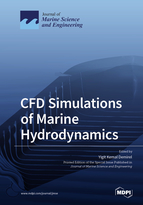CFD Simulations of Marine Hydrodynamics
A special issue of Journal of Marine Science and Engineering (ISSN 2077-1312). This special issue belongs to the section "Ocean Engineering".
Deadline for manuscript submissions: closed (31 December 2020) | Viewed by 76153
Special Issue Editor
Interests: marine hydrodynamics; computational fluid dynamics; ship resistance and propulsion; fouling/coating hydrodynamics; seakeeping; fouling-control coatings; numerical modeling
Special Issues, Collections and Topics in MDPI journals
Special Issue Information
Dear Colleagues,
This Special Issue focuses on Computational Fluid Dynamics (CFD) Simulations of Marine Hydrodynamics with a specific focus on the applications of naval architecture and ocean engineering. CFD is an emerging area and is gaining popularity due to the availability of ever-increasing computational power. If used accurately, CFD methods may overcome the limitations of experimental and other numerical methods, in some respects.
We invite researchers from both academia and industry to submit original articles that advance state-of-the-art CFD applications in marine hydrodynamics or review the progress and future directions of research in this field. The scope of the Special Issue covers the range of subjects relevant to naval architecture and ocean engineering.
Dr. Yigit Kemal Demirel
Guest Editor
Manuscript Submission Information
Manuscripts should be submitted online at www.mdpi.com by registering and logging in to this website. Once you are registered, click here to go to the submission form. Manuscripts can be submitted until the deadline. All submissions that pass pre-check are peer-reviewed. Accepted papers will be published continuously in the journal (as soon as accepted) and will be listed together on the special issue website. Research articles, review articles as well as short communications are invited. For planned papers, a title and short abstract (about 100 words) can be sent to the Editorial Office for announcement on this website.
Submitted manuscripts should not have been published previously, nor be under consideration for publication elsewhere (except conference proceedings papers). All manuscripts are thoroughly refereed through a single-blind peer-review process. A guide for authors and other relevant information for submission of manuscripts is available on the Instructions for Authors page. Journal of Marine Science and Engineering is an international peer-reviewed open access monthly journal published by MDPI.
Please visit the Instructions for Authors page before submitting a manuscript. The Article Processing Charge (APC) for publication in this open access journal is 2600 CHF (Swiss Francs). Submitted papers should be well formatted and use good English. Authors may use MDPI's English editing service prior to publication or during author revisions.
Keywords
- ship resistance and propulsion
- seakeeping and maneuverability
- vortex-induced motions (VIM) and vortex-induced vibrations (VIV)
- validation and verification of computational fluid dynamics (CFD)
- EFD/CFD combined methods
- drag reduction technologies
- fouling/coating hydrodynamics






